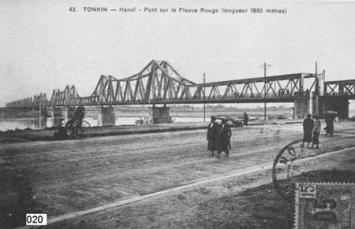It is a historic cantilever bridge across the Red River that connects two parts of the city of Hanoi, Vietnam. It is also commonly referred to as the Paul Doumer Bridge.

It was built in 1903 by the French architect Gustave Eiffel. Before Vietnam’s independence in 1954, it was called Doumer Bridge, named after Paul Doumer – The Governor-General of French Indochina and then French president. It was, at that time, one of the longest bridges in Asia with the length of 2,500 m.[1]
For the French colonial government, the construction was of strategic importance in securing control of northern Vietnam. From 1899 to 1902, more than 3,000 Vietnamese took part in the construction. At the time, the bridge was one of the longest in Asia.
Defence of the bridge played a major role in the Vietnam War against the United States, as the bridge provided a secure connection to the port of Haiphong. The first attack took place in 1967, and the center span of the bridge was felled by an attack by 20 USAF F-105 Fighters[2]. The defence of Long Bien Bridge continues to play a large role in Hanoi’s self-image and is often extolled in poetry and song.
It was heavily bombarded during Vietnam War due to its critical position (the only bridge at that time across the Red River and connect Hanoi to the main port Haiphong). It was rendered unusable for a year when, in May 1972, it fell victim to one of the first co-ordinated attacks using laser-guided “smart bombs”. Nowadays, only half of the bridge retains its original shape. A project with support and loan from French government is currently in progress to rebuild the bridge to the original state.
Today trains, mopeds, bicycles and pedestrians use the dilapidated bridge, while all other traffic is diverted to the nearby Chuong Duong Bridge and some newly built bridges: Thanh Tri Bridge, Thang Long Bridge, Vinh Tuy Bridge, and Nhat Tan Bridge.
Under the bridge, around 40 extremely poor families live in boats on Red river coming from many poor rural of Viet Nam.
The bridge now stands like a patched-up war veteran. Some parts of the original structure remain intact, while large sections have clearly been built later to repair the holes. In this way the bridge is a strong visual expression of history.
The land of Quang Binh is favored by nature, possessing a large, pristine system of both large and small caves, which...
The phrase “Mekong River – A Buddhist River” describes the cultural heritage of Buddhism in the...
The Independence Palace has been existing for 154 years; however, the Independence Palace you see today was erected in...
The resort is located 80 kms North of Nha Trang at the tip of an archipelago. It is absolute paradise – an ideal...
Being is one of the well-known beaches in the north of Vietnam, Do Son is a small peninsular formed by the stretch of...
Ca Na beach On the map of Vietnam tourism as well as the world’s, Ca Na is amongst the impressive names for a...
Entrance to the Cham Museum Situated in a quiet area of Da Nang City, Cham Museum was built in 1915 according to the...
Phu Quy Island, whose name means “rich and precious,” lies about 100 km to the east of Phan Thiet City;...